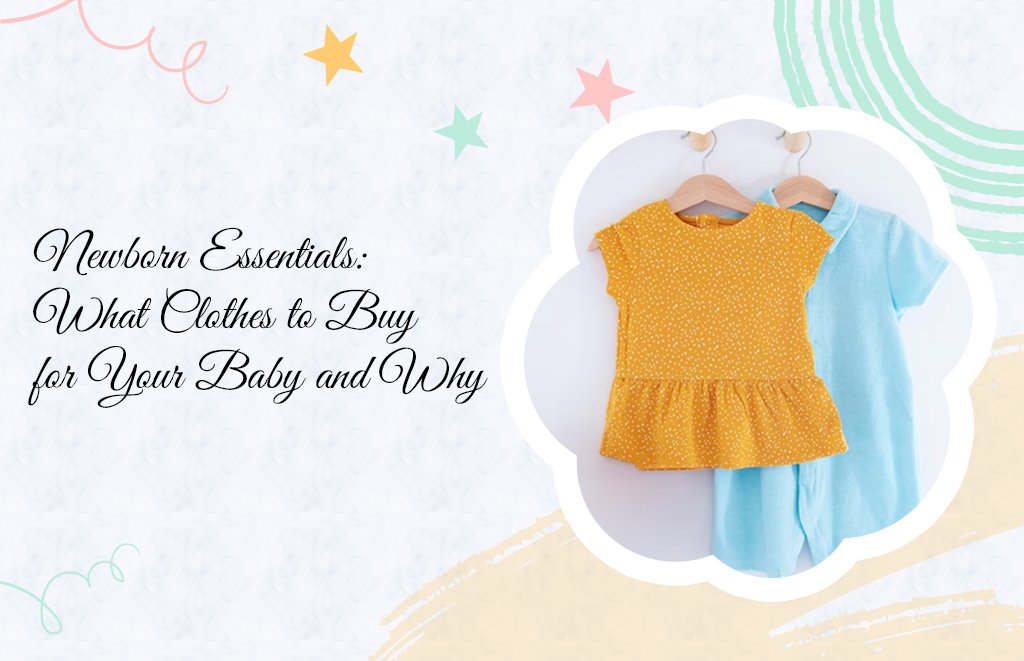If you are expecting a baby soon, you might wonder what clothes you must buy for your little one. Babies grow fast and need frequent changes in clothes, so deciding what to buy and how much can be challenging. This blog post will help you with a list of newborn essentials that will keep your baby comfortable, cosy and cute. We will also explain why these clothes are essential and how to care for them properly.
Table of Contents
– Introduction
– List of Recommended Clothes
– Bodysuits
– Sleepsuits
– Vests
– Hats
– Socks and Booties
– Mittens
– Swaddles and Blankets
– Jackets and Cardigans
– Fabric Guide
– Size Guide
– How to Care for Baby Clothes
– Pros and Cons of Buying Newborn Clothes
– Conclusion
Introduction
Clothing is the first item you need to purchase for your newborn child. Buy soft fabrics and avoid glitter, heavy embellishments, sequins, ribbon, ties, and buttons, as these might pose choking risks or cause skin irritation. Newborn baby garments must be comfy, cotton-based, and have safe motifs, if any.
During those newborn days, it’s essential to focus on comfort and practicality, opting for easy-change cotton bodysuits, vests and sleepsuits that are gentle on sensitive skin. Start with a modest assortment (eight of each works nicely), and you can always add more once you know your baby’s weight and size.
Consider the season and the climate when buying newborn clothes. For example, if your baby is born in winter, you will need warmer clothes like jackets, cardigans, hats and socks. If your baby is born in summer, you will need lighter clothes like shorts, dresses and sun hats.
In this blog post, we will give you a list of recommended clothes that you can buy for your newborn baby. We will also explain why these clothes are essential and how to care for them properly.
List of Recommended Clothes
Here are some of the essential clothes that you should buy for your newborn baby:
Bodysuits
Bodysuits are one-piece outfits that cover the torso and have snaps at the crotch for easy diaper changes. They can be worn alone or under other clothes. Bodysuits are great for newborns because they keep them snug and warm without restricting their movements. They also prevent the diaper from sagging or leaking.
You can choose from different styles of bodysuits, such as short-sleeved, long-sleeved or sleeveless. You can also find bodysuits with different prints, colours and patterns to suit your preference. Some bodysuits have cute slogans or designs that make them more fun and adorable.
You should buy at least eight bodysuits for your newborn baby. To create various outfits, mix and match them with other clothing or accessories.

Sleepsuits
Sleepsuits are also one-piece outfits covering the whole body from neck to foot. They usually have snaps or zippers at the front or back for easy dressing and changing. Sleepsuits are ideal for bedtime or naptime because they keep your baby cosy and comfortable. They also protect your baby from scratches or insect bites.
You can choose from different types of sleepsuits, such as footed or footless. Footed sleepsuits have built-in socks that keep your baby’s feet warm and prevent them from slipping off. Footless sleepsuits allow your baby’s feet to breathe, giving them more room to wiggle. For extra warmth, you can also find sleepsuits with hoods, mittens or collars.
You should buy at least eight sleepsuits for your newborn baby. You can choose different fabrics depending on the season, such as fleece for winter or cotton for summer.
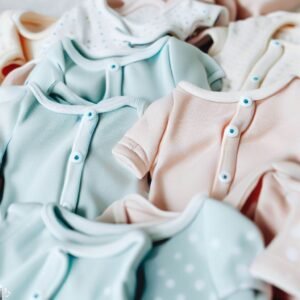
Vests
Vests are sleeveless tops that cover the chest and stomach. They can be worn under other clothes or alone in warm weather. Vests are helpful for newborns because they provide an extra layer of warmth and absorb sweat. They also prevent the diaper from rubbing against the skin.
You can choose from different styles of vests, such as round-necked or V-necked ones. You can also find vests with different prints, colours and patterns to match your baby’s personality. Some vests have snaps at the shoulder or side for easy dressing and changing.
You should buy at least eight vests for your newborn baby. You can layer them with other clothes or accessories to create different outfits.
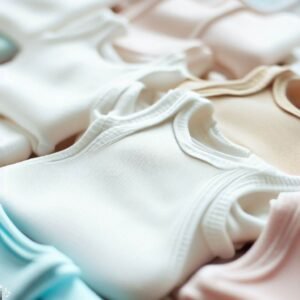
Hats
Hats are accessories that cover the head and ears. They can be worn for protection or fashion. Hats are essential for newborns because they help regulate their body temperature and prevent heat loss. They also shield their eyes and skin from the sun or wind.
You can choose from beanies, caps, bonnets or sun hats. You can also find hats with different features, such as ear flaps, chin straps or pom-poms. Some hats have cute motifs or designs that make them more attractive and fun.
You should buy at least two hats for your newborn baby. Depending on the season, you can choose different materials, such as wool for winter or cotton for summer.
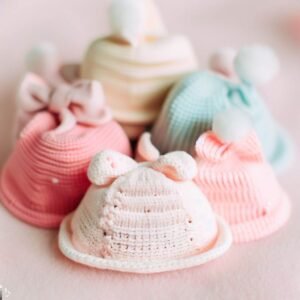
Socks and Booties
Socks and booties are footwear that covers the feet and ankles. They can be worn with or without shoes. Socks and booties are essential for newborns because they keep their feet warm and cosy. They also prevent their toes from curling or getting injured.
You can choose from different styles of socks and booties, such as plain, patterned or frilly ones. You can also find socks and booties with additional features like grips, ribbons or bells. Some socks and booties have cute characters or animals, making them more appealing and playful.
You should buy at least six pairs of socks and booties for your newborn. You can mix and match them with other clothes or accessories to create different looks.
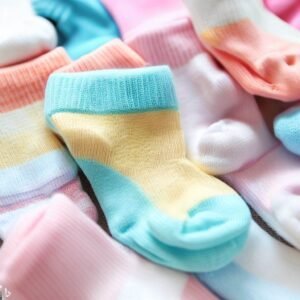
Mittens
Mittens are gloves that cover the hands and fingers. They can be worn for protection or comfort. Mittens are beneficial for newborns because they prevent them from scratching their faces or sucking their thumbs. They also keep their hands warm and soft.
You can choose from different types of mittens, such as knitted, fleece or cotton ones. You can also find mittens with extra features, such as snaps, strings or elastic cuffs. Some mittens have cute shapes or colours, making them more adorable and cheerful.
You should buy at least four pairs of mittens for your newborn baby. You can choose different sizes depending on the growth of your baby’s hands.
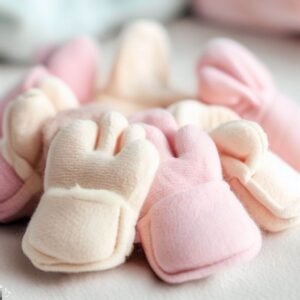
Swaddles and Blankets
Swaddles and blankets are pieces of fabric that wrap around the body. They can be used for sleeping, cuddling or nursing. Swaddles and blankets are helpful for newborns because they provide a sense of security and comfort. They also mimic the womb environment and promote better sleep.
You can choose from different swaddles and blankets, such as muslin, flannel or fleece. You can also find swaddles and blankets with other features, such as Velcro, zippers or snaps. Some swaddles and blankets have beautiful prints or patterns that make them more attractive and soothing.
You should buy at least four swaddles and blankets for your newborn baby. You can choose different weights depending on the season, such as light for summer or heavy for winter.
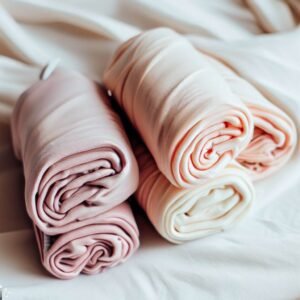
Jackets and Cardigans
Jackets and cardigans are outerwear that covers the upper body. They can be worn over other clothes or alone in cold weather. Jackets and cardigans are necessary for newborns to protect them from the cold and wind. They also add style and flair to their outfits.
You can choose from jackets and cardigans, such as hooded, buttoned or zipped ones. You can also find jackets and cardigans with different features, such as pockets, collars or cuffs. Some jackets and cardigans have lovely textures or colours, making them more fashionable and charming.
You should buy at least two jackets and cardigans for your newborn baby. You can choose different fabrics depending on the season, such as wool for winter or cotton for summer.
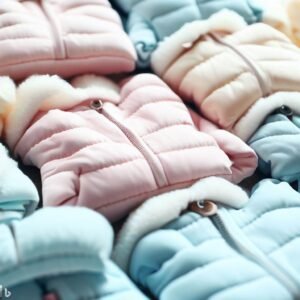
Fabric Guide
When buying clothes for your newborn baby, you should pay attention to the fabric they are made of. The material affects the comfort, durability and safety of the clothes. Here are some of the common fabrics used for baby clothes:
– Cotton: Cotton is a natural fibre that is soft, breathable and hypoallergenic. It is ideal for baby clothes because it is gentle on the skin, absorbs moisture and regulates temperature. However, cotton can shrink, fade or wrinkle easily if improperly washed.
– Polyester: Polyester is a durable, wrinkle-resistant synthetic fibre that is easy to care for. It suits baby clothes because it is lightweight, quick-drying and stain-resistant. However, polyester can trap heat, cause static electricity or irritate sensitive skin.
– Fleece: Fleece is a synthetic fabric that is warm, cosy and fluffy. It is perfect for baby clothes because it is insulating, water-repellent and machine-washable. However, fleece can pill, shed or catch fire easily if not handled carefully.
– Wool: Wool is a natural fibre that is warm, soft and breathable. It is ideal for baby clothes because it is insulating, moisture-wicking and odour-resistant. However, wool can be itchy, shrink or feel easily if not washed properly.
Size Guide
When buying clothes for your newborn baby, you should also pay attention to the size they are labelled with. The size can vary by brand, age or weight of the baby. Here are some of the standard size options you will see:
Preemie: This size is for babies born prematurely or weighing less than 2.5 kg (5.5 lb). It usually corresponds to 44 cm (17 inches) in height.
– Newborn (NB): This size is for babies who are born at term or weigh between 2.5 kg (5.5 lb) and 4 kg (8.8 lb). It usually corresponds to 50 cm (19.5 inches) in height.
– 0-3M: This size is for babies between 0 and 3 months old or weighing 4 kg (8.8 lb) and 6 kg (13.2 lb). It usually corresponds to 56 cm (22 inches) in height.
– 3-6M: This size is for babies between 3 and 6 months old or weighing 6 kg (13.2 lb) and 8 kg (17.6 lb). It usually corresponds to 62 cm (24.5 inches) in height.
– 6-9M: This size is for babies between 6 and 9 months old or weighing 8 kg (17.6 lb) and 9 kg (19.8 lb). It usually corresponds to 68 cm (27 inches) in height.
– 9-12M: This size is for babies between 9 and 12 months old or weighing 9 kg (19.8 lb) and 10 kg (22 lb). It usually corresponds to 74 cm (29 inches) in height.
– 12-18M: This size is for babies between 12 and 18 months old or weighing 10 kg (22 lb) and 11 kg (24.2 lb). It usually corresponds to 80 cm (31.5 inches) in height.
– 18-24M: This size is for babies between 18 and 24 months old or weighing 11 kg (24.2 lb) and 13 kg (28.6 lb). It usually corresponds to 86 cm (34 inches) in height.
However, these sizes are approximate and may not fit your baby perfectly. To find the best fit for your baby, measure their height, chest, waist and low hip and compare them with the specific size chart of the brand you are buying from². You can also check the reviews of other parents who have bought the same clothes to see how they fit their babies.
How to Care for Baby Clothes
Once you have bought the clothes for your newborn baby, you need to take good care of them to make them last longer and keep them hygienic. Here are some tips on how to care for baby clothes:
– Wash new clothes before wearing them. New clothes may have chemicals, dust or germs that can irritate your baby’s skin or cause allergies. Wash them with mild detergent and warm water before putting them on your baby.
– Separate dark and light colours. Dark colours may bleed or fade onto light colours if washed together. Separate them into different loads and wash them separately to prevent staining or discolouration.
– Use a gentle cycle and low temperature. Baby clothes are delicate and can be damaged by harsh washing or drying. Use gentle cycle and low-temperature settings on your washing machine and dryer to prevent shrinking, stretching or tearing.
– Avoid bleach and fabric softeners. Bleach can damage the fabric and cause skin irritation or allergic reactions. Fabric softeners can reduce the absorbency and breathability of the material and leave residue on the clothes. Avoid using them on baby clothes or use natural alternatives like vinegar or baking soda.
– Dry flat or hang dry. Drying baby clothes in a dryer can cause them to shrink, wrinkle or lose shape. Dry them flat on a towel or hang them on a line to air dry naturally and preserve their quality.
– Iron with care. Ironing baby clothes can remove wrinkles and make them look neat and fresh. However, ironing can damage some fabrics or cause burns if done incorrectly. Iron with care and follow the instructions on the label of the clothes.
Pros and Cons of Buying Newborn Clothes
Buying newborn clothes can be a fun and exciting experience for parents-to-be. Still, it can also be a daunting and expensive one. Here are some of the pros and cons of buying newborn clothes:
Pros
– You can prepare for your baby’s arrival and have everything ready for them.
– Your baby’s clothing and accessories can reflect your taste and personality.
– You can enjoy dressing up your baby and taking cute photos and videos of them.
– You can bond with your baby and make them feel comfortable and loved by choosing soft and cosy clothes.
Cons
– Depending on their growth rate and needs, you may buy too many or too few clothes for your baby.
– You may save money on clothes your baby will outgrow quickly or never wear.
– You may need help finding the right size, fit or quality for your baby’s clothes among different brands and styles.
– You may have to spend a lot of time and effort washing, drying, ironing and organizing your baby’s clothes.
FAQ
– How many clothes do I need for my newborn?
There is no definitive answer to this question, as it depends on various factors, such as how often you do laundry, how fast your baby grows, and how messy your baby gets. However, a general rule of thumb is to have enough clothes for at least one week. You can use the checklist in this blog post as a guide to determine how many clothes you need for each category.
– What are the best fabrics for newborn clothes?
The best fabrics for newborn clothes are soft, breathable, durable, and easy to wash. Some of the best materials are cotton, muslin, flannel, wool, and fleece. Avoid rough, scratchy, synthetic fabrics or prone to shrinking or fading.
– How do I choose the right size for newborn clothes?
The right size for newborn clothes is the one that fits well and not too tight or too loose. You can measure your baby’s height and weight and check the size chart of the brand or store you are buying from. You can also try on the clothes before buying them or buy them with a return policy. You can also buy clothes in different sizes and keep the tags on until you use them.
– How do I consider the season when dressing my baby?
You should dress your baby according to the season and the weather. Choose clothes that match the temperature and humidity level of your location. Layer the clothes according to the weather conditions and adjust them as needed. For summer, choose light, airy, and sun-protective garments. For winter, choose warm, cosy, and wind-resistant clothes.
– How do I wash newborn clothes?
It would help if you washed newborn clothes before wearing them for the first time to remove any dirt or germs. Washing them separately from other garments would prevent staining or damage. It would help to pass them in cold water with mild detergent and a gentle cycle to preserve their quality and colour. You should also follow the washing instructions on the labels of the clothes.
– How do I dry newborn clothes?
It would help if you dried newborn clothes in low heat with a dry tumble setting to prevent shrinking or wrinkling. It would allow them to dry separately from other garments to avoid lint or pilling. You should also dry them thoroughly before folding or storing them to prevent mold or mildew.
– How do I store newborn clothes?
You should store newborn clothes in a clean, dry, and cool place to prevent dust or insects. It would help if you kept them in drawers, closets, or bins with labels or dividers to organize them. Store them by size, type, or season to make them easy to find and use.
– Where can I buy newborn clothes?
You can buy newborn clothes online or in stores. Online shopping offers convenience, variety, and discounts. However, you should check the online seller’s reviews, ratings, and return policy before buying. In-store shopping provides personal service, fitting rooms, and instant gratification. However, you should check the in-store products’ quality, price, and availability before buying.
– What are some tips to save money on newborn clothes?
Some tips to save money on newborn clothes are:
– Buy clothes in packs or sets instead of individual pieces
– Buy clothes in neutral colours or unisex styles that can be mixed and matched
– Buy clothes in larger sizes that can last longer
– Buy clothes during sales or clearance events
– Buy clothes from second-hand stores or online marketplaces
– Borrow or swap clothes from friends or family members who have babies
– What are some tips to make newborn clothes more fun and fashionable?
Some tips to make newborn clothes more fun and fashionable are:
– Add accessories such as hats, socks, mittens, or bows
– Choose clothes with cute slogans, graphics, or characters
– Choose clothes with different textures or features such as quilts, knits, or sherpa
– Choose clothes with bright colours or patterns such as stripes, polka dots, or florals
– Choose clothes that match your own style or personality
Conclusion
Buying clothes for your newborn baby can be rewarding and enjoyable if you know what to look for and how to care for them. This blog post lists newborn essentials to keep your baby comfortable, cozy and cute. We have also explained why these clothes are essential and how to choose the suitable fabric and size. We hope this guide will help you find the best clothes for your baby and make them happy and healthy. Happy shopping!

